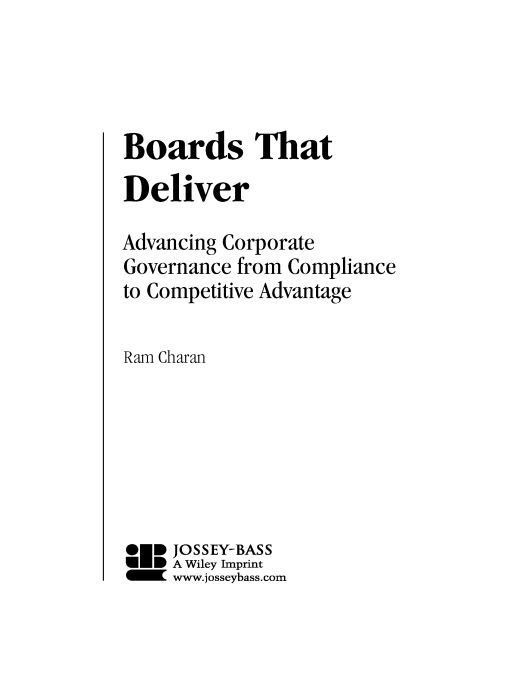Table of Contents
Other Books by Ram Charan
Profitable Growth Is Everyones Business: 10 Tools You Can Use Monday Morning
What the CEO Wants You to Know
Boards at Work
Books coauthored by Ram Charan:
Confronting Reality: Doing What Matters to Get Things Right
(a best-seller with Larry Bossidy)
Execution: The Discipline of Getting Things Done
(a best-seller with Larry Bossidy)
The Leadership Pipeline: How to Build the Leadership-Powered Company (with James L. Noel and Steve Drotter)
Every Business Is a Growth Business: How Your Company Can Prosper Year after Year (with Noel Tichy)
E-Board Strategies (with Roger Kenny)
Strategic Management: A Casebook in Policy and Planning
(with Charles W. Hofer, Edwin A. Murray Jr., and Robert A. Pitts)
Custom books for in-house use:
Business Acumen
Making Matrix Organizations a Competitive Advantage
Action, Urgency, Excellence
Introduction: Advancing the Practice of Corporate Governance
Make no mistake about it, corporate governance is on the move. New rules and regulations, along with a genuine desire to improve, have caused a perceptible shift in boardrooms across America and around the world. Most CEOs and directors recognize that the journey has just begun, and that they, not regulators, must now lead the way.
This is a book for directors, CEOs, and other business leaders who want corporate governance to be the best it can be. Yes, boards have changed in recent years for the better. But they are not yet fully evolved. Most boards are in flux and still not living up to their potential of providing truly good governancethat is, governance that doesnt just prevent misdeeds but actually improves the corporation. They havent figured out the how of adding value.
Thats where this book comes in. It provides the guidance boards need to go from being merely active and in full compliance to making an important contribution to the business. It is a road map for how boards can make the transition to the next step in their evolution, becoming a competitive advantage for their companies. And it is a guidebook for CEOs to see how they can get the most out of their boards.
Beginning with my doctoral work on governance at the Harvard Business School more than thirty years ago, I have closely studied the inner workings of boards. I havent performed quantitative or statistical correlations between corporate performance and variables of corporate governance. Frankly, such research doesnt get to the causality of what leads to good governance. Rather, I have focused on what happens behind the curtain, so to speak, inside the boardroom. My first book on this subject, Boards at Work (published in 1998), described what the best boards were doing at that time.
Since then, through continued research and analysis, I have come to identify three factors that create the foundation for good governance. I have also identified the essential practices and collective behaviors needed to build that foundationand to build on it. These are practices and behaviors I have observed to have a positive impact on governance for the companies that used them. That is, they seem to be causal factors. They can be adopted by any board to make good governance a reality.
My view of what makes governance good differs from that of so-called board watchers. To them, governance is measured by inputsthe processes and structures used by the board. To the contrary, I believe governance is measured by outputsthe value that a board adds to a corporation. A boards practices are a means by which it can perform good governance, not ends in and of themselves.
Though this book mostly describes practices in the United States, the principles of a boards work hold true around the world. Virtually all nations corporate codes charge some form of board with the task of ensuring the successful perpetuation of the firm over the long term. The influence of shareholders may be stronger in nations such as the United Kingdom or weaker in nations such as Korea. The composition of boards may emphasize employees in nations like Germany or emphasize independent directors in nations like the United States. Regardless of the differences in mechanics and rules, the boards fundamental mandate is the sameand the characteristics necessary for it to function well are universal.
This book does not describe the myriad requirements for compliance. It doesnt list the rules prescribed by Sarbanes-Oxley, for example, and by the stock market exchanges. CEOs, directors, and general counsels know these rules intimately by now, or have access to comprehensive sources of advice on compliance. The aim here is to prompt boards to continue their momentum, to build on their accomplishments to date, and to put in place the collective behaviors and practices that will allow them to deliver on the promise of good governance once and for all.
The Road Map
Part One of this book identifies the current state of transition many boards find themselves in. Chapter One defines the three evolutionary stages of corporate boards: Ceremonial, Liberated, and Progressive. It ends with a self-test for boards to evaluate themselvesWhere Does Your Board Stand?
Chapter Two describes the three building blocks that are essential to move from Liberated, where most boards are today, to Progressive. These building blocks are not what external observers are focusing on. Board watchers have become preoccupied with the size of a board, the degree of independence, the number of committees and meetings, the separation of the CEO and Chair positions, and other such variables, none of which gets at the heart of Progressive governance. The true causal factors that lead to better governance are group dynamics, information architecture, and focus on substantive issues, which I outline.
Part Two of the book includes a chapter on each of the three building blocks, to present an in-depth look at the practices and collective behaviors that boards can use to transform themselves into Progressive boards. Chapter Three describes the practices that are essential to the boards group dynamics, the first building block of Progressive boards. Readers will quickly understand how simple techniques can transform the manner in which directors interact with each other, and with management, and become a productive force for governance.
Chapter Four describes the best practices that Progressive boards use to ensure an efficient and productive exchange of information between management and the board. Getting the information architecture right has profound effects on the quality of dialogue in the boardroom.
Chapter 5 describes the best practices that Progressive boards use to focus on substantive issues. Boards time and attention are very precious. The trap some boards fall into is to allow their time to be dominated by routine financial monitoring and compliance activities. Progressive boards use simple tools to remind themselves of the most critical areas and improve the return on their time.
Part Three of the book includes a chapter on each of five substantive areas where boards can make their most important contributions: the right CEO and succession, CEO compensation, the right strategy, the leadership gene pool, and monitoring health, performance, and risk. In practice, boards tend to give these areas relatively little of their time and attention, yet these are the real opportunities for a board to become a true competitive advantage.




